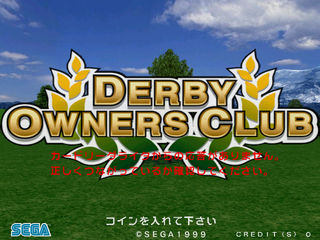Derby Owners Club
From Sega Retro
| Derby Owners Club | |||||||||
|---|---|---|---|---|---|---|---|---|---|
| System(s): Sega NAOMI Satellite Terminal | |||||||||
| Publisher: Sega | |||||||||
| Developer: Sega Software R&D Dept. 3[1] | |||||||||
| Genre: Table | |||||||||
| Number of players: 1-8 | |||||||||
|
This teeny-tiny article needs some work. You can help us by expanding it.
Derby Owners Club (ダービーオーナーズクラブ) is a horse racing simulator developed by Sega AM3 and published by Sega for the Sega NAOMI arcade platform. The game was an arcade exclusive, with no home conversion. Players use one of several consoles (called satellites) to train horses, and then race them against 11 other CPU or human-controlled horses on a huge screen.
Contents
Gameplay
Each player acts as owner, trainer, and jockey at each console. To create a horse, the player assumes the role of Breeder and must begin by choosing the Sire and Dam. Once the horse is born, the player names it and chooses the pattern and color for their jockey's silks. Then it's off to the training farm, where the player is now the Trainer.
Training consists of selecting a training regime from a menu of ten different mini-games. Each exercise develops the horses racing abilities, which include Starting, Cornering, Out of the Box, Tenacity, Competitiveness, and Spurt. After training, players choose from a variety of foods to feed their horse. The horses' abilities will develop differently depending on which minigame was chosen, how well the player did in the minigame, and which food was chosen for the horse.
After training and feeding their horse, the player can race their horse against other players or the CPU. At this point the player has taken on the role of the Jockey, using their whip at strategic times to maximize their horse's performance. Players win prize money for finishing the race, the higher the position in the race, the more prize money their horse wins.
Once the race is over, the player takes on the final role of Owner and is asked a multiple choice question to test the understanding he/she has of their horse (its likes, dislikes, etc). The wrong answer will have a negative affect on the relationship between player and horse.
Much like in real horse racing, after 30-40 races, the player's horse becomes "old" and slows down compared to younger horses. Once a horse has run in 20 races, the player can opt to retire it to the breeding stable, where it can be used as the sire or dam of future champions. However, doing so makes it impossible to ever race the horse again.
Sega's Memory Card Reader and Dispenser Technology (MCRD)
For each horse created, a unique Horse Owner's Card is printed out by the machine. All of the data from training, feeding, and racing the horse is stored on the card, which can be scanned at any Derby Owner's Club console so that players may pick up where they left off. This allows players to slowly build their horse's abilities and increase the amount of prize money collected.
History
Legacy
The game was followed by a number of sequels, the first of which was Derby Owners Club 2000. A remake was released in 2012 for iOS and 2013 for Android. Sega Logistics Service announced it would end service on the machines for the original arcade version on March 31, 2017.[2][3]
Production credits
- Producer: Hisao Oguchi[4][5]
- Tomosuke Tsuda[6]
- Takuya Onuma[6]
- Programmer: Tadashi Kagawa[6], Daisuke Ide[7], Masataka Noda[8]
- Chief Designer: Kiyoshi Miyagi[9]
- Artist: Masaki Miyashita[10], Yasuhito Tanaka[11], Yasuto Muraki[12], Masamitsu Hoshino[13]
- Sound: Taihei Sato[14]
- Publicity: Shintaro Takaya[15]
- Electric Engineer: Junichi Kobayashi[6]
Magazine articles
- Main article: Derby Owners Club/Magazine articles.
Physical scans
| NAOMI, JP | ||||
|---|---|---|---|---|
External links
- You’re Not an Arcade Geek Unless You Played This Game article by David Hill at Lifestyle
References
- ↑ 1.0 1.1 Sega Arcade History, Enterbrain, page 169
- ↑ File:SegaProductsTerminationAnnouncement 2016-11 JP.pdf
- ↑ File:SegaProductsTerminationAnnouncement 2016-12.pdf
- ↑ Dreamcast Magazine, "1999-35 (1999-11-12)" (JP; 1999-10-29), page 157
- ↑ https://sega.jp/fb/album/02_dp/02.html (Wayback Machine: 2021-10-09 22:30)
- ↑ 6.0 6.1 6.2 6.3 https://jglobal.jst.go.jp/detail?JGLOBAL_ID=200903053540079902
- ↑ http://www.hitmaker.co.jp/top/lounge/corumun/site/corumun_txt56.htm (Wayback Machine: 2002-02-13 04:49)
- ↑ http://www.hitmaker.co.jp/top/lounge/corumun/site/corumun_txt75.htm (Wayback Machine: 2003-08-04 21:26)
- ↑ http://www.hitmaker.co.jp/top/lounge/corumun/site/corumun_txt02.html (Wayback Machine: 2002-10-22 10:13)
- ↑ http://www.hitmaker.co.jp/top/lounge/corumun/site/corumun_txt24.html (Wayback Machine: 2003-04-22 21:57)
- ↑ http://www.hitmaker.co.jp/top/lounge/corumun/site/corumun_txt41.htm (Wayback Machine: 2002-12-14 14:24)
- ↑ http://www.hitmaker.co.jp/top/lounge/corumun/site/corumun_txt57.htm (Wayback Machine: 2003-08-04 19:05)
- ↑ http://www.hitmaker.co.jp/top/lounge/corumun/site/corumun_txt95.htm (Wayback Machine: 2003-06-25 18:02)
- ↑ http://sega.jp/segamoba/news/nr_060124.html (Wayback Machine: 2007-12-11 10:20)
- ↑ http://www.hitmaker.co.jp/top/lounge/corumun/site/corumun_txt18.html (Wayback Machine: 2003-04-06 08:02)
| Games in the Derby Owners Club Series | |
|---|---|
| Derby Owners Club (1999) | Derby Owners Club 2000 (2000) | Derby Owners Club World Edition (2001) | Derby Owners Club 2 (2002) | Derby Owners Club 2008: Feel the Rush (2008) | Derby Owners Club 2009: Ride for the Live (2009) | |
| Derby Owners Club Online (2004) | |
| Derby Owners Club (2012) | |
| Derby Owners Club (2013) | |
| Derby Owners Club related media | |
| Derby Owners Club: Perfect Audio Collection (2006) | Derby Owners Club 2008: Feel the Rush Soundtrack (2009) | |
